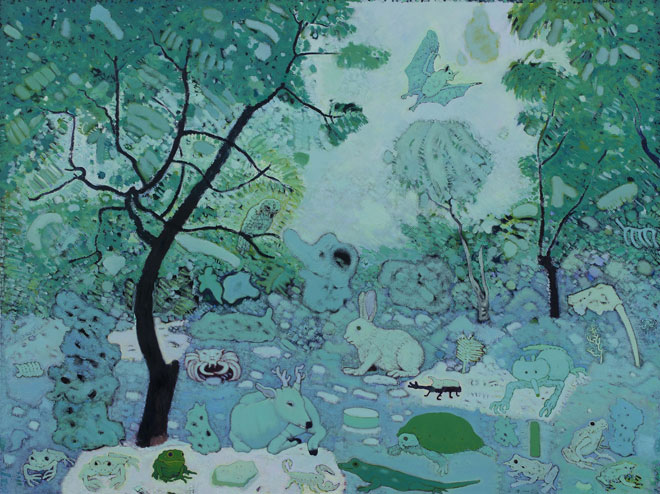“Acquisition from Fairy Mountain,” Shi Xinji solo exhibition
AYE Gallery (Room 601, Unit 3, Yonghe Garden, Dongcheng, Beijing) Mar 3 – May 8, 2013
What is the effect when an exhibition is recommended? Of course, it depends on the source: if one values their judgement, expectations are lighted — a will to like it, even, conscious or unconscious. If not — and before one has even seen it — a flat feeling might develop around the show in question, similar to that of receiving a compliment on an outfit from someone whose taste one dislikes. “Acquisition from Fairy Mountain” falls into the former category — a fortunate thing in view of an exhibition title that does little to ignite the passions.
A modest arrangement of works in AYE Gallery represents the first solo show for 34-year-old artist Shi Xinji. Facing the entrance to the gallery are two paintings — an odd couple, aptly paired. On the right, an appealing picture of a bear smiling raptly out from a small 60 x 50 cm canvas (this is “Distant Mountain,” 2011); to its left, a large painting with a similarly low horizon line dividing a strong orange backdrop and red ground on which stands a figure of Van Gogh (“Van Gogh Hillman,” 2009). One describes “a figure” of the artist — certainly an uncharacteristic portrayal. The head is recognizable from Van Gogh’s many self-portraits; large, heavy eyes and the dark, angular outline of the right cheek, hair ploughed back above a thick red beard and definite nose. This serious mask is contested utterly, however, by the bright green suit and psychedelic-patterned shirt below it which make this familiar visage tragicomic; black round-toed boots, dark fingernails and a stiff, slightly too-small body complete this awkward image, torn between 1970s flaunt and art history’s vast, sober mound. At the feet of the painter to the left is a strange blue hedgehog, framed by a red semi-circular sunset — an element one is inclined not to try to construe.
The exhibition unfolds into slower-acting canvases depicting landscape, flora and fauna in Shi’s particular animist mode. “East Garden” is an aqua-hued scene of creatures congregating around a tree with a dark trunk. The paint has a spongy texture which rather befits the benign appearance of the animals; they share the same beady eyes and untroubled expressions, content in their greenish pelts – the scene is a communion of color and creatures, as if all are bathed in the same light, both literal and metaphorical. For some it may be too naïve, but this painting, like certain others in the show, emanates a pleasant mood which there seems no reason not to accept. Nearby are two large canvases (both called “The South Mountain,” 2012), each containing lurid nocturnal views of rocky mountainsides peopled with spare trees in the foreground, peaks and pines behind. The unusual purple and mauve tones here lend interest, as does the ethereal effect of yellow highlights around tree branches in the left hand panel. A red-eyed monkey, seemingly large, might remind one loosely of Rousseau’s animal-characters peering from their ample habitats. Another of the paintings exemplifies the simpler manner in which the artist chooses sometimes to paint plants and rocks — “Immortal Fruits” (2008), in which a few boulders flank a delicate plant, fruit hanging from a branch calmly unfinished by the painter’s hand, left merely sketched in in orange.
There is a clear will amongst these works to evoke the spirit of a natural world to which the artist feels attuned. This spiritual reach may not grasp their every viewer; nonetheless, one is drawn to the anomalous character of the Van Gogh image, as well as the natural scenes which are not without their own artistry and affect. Beyond anything more complex, one is compelled to enjoy them.



